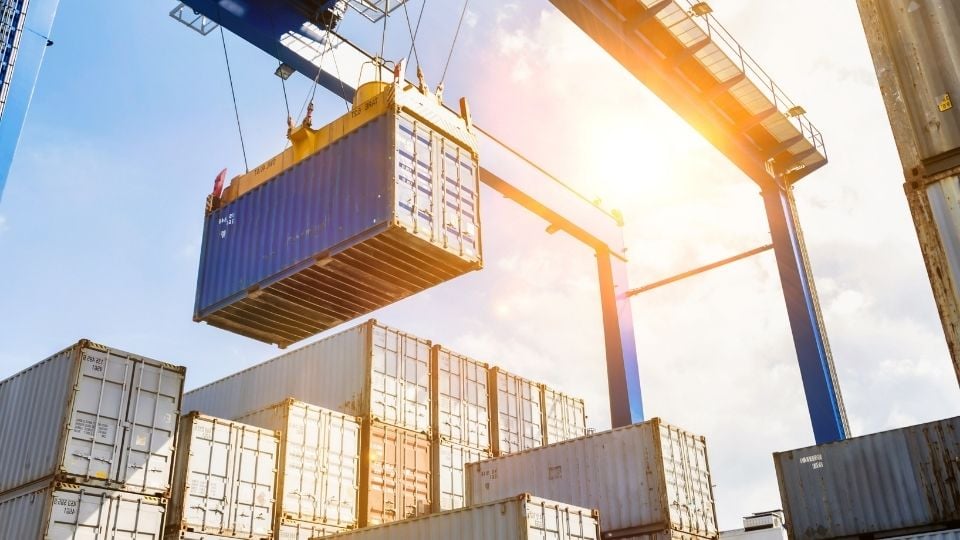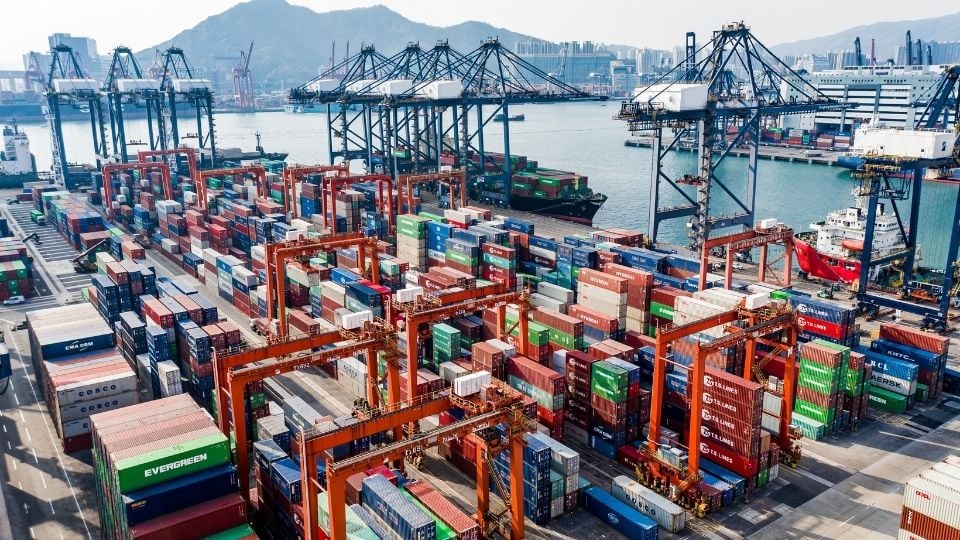Container Terminals: How is semi-automation increasing productivity?
| Written by Mark Buzinkay
One-third of container terminal operators see automation as a way to increase productivity by up to 50%. At the same time, about one fifth believe that automation could cut operational costs by more than 50%.
But less flexibility for operational planning, new scenarios that have to be previously planned, more difficulty to react when exceptions occur must be taken into account when expecting higher productivity. A semi-automated container terminal is in the most cases the way to go.

No video selected
Select a video type in the sidebar.
Table of contents:
- Automation & Productivity
- Consequences of Full Automation
- Preparing For Task Automation: Key Steps to Maximise Efficiency
- The Optimum Way: Semi-Automation
- Takeaway
- Glossary
Container terminals efficiency is often associated with productivity and performance. With regards to the growing international sea traffic and changing technology in the maritime transport industry, seaports are coping with mounting pressures to upgrade and provide cutting-edge technology. As a result, they are forced to improve container terminal efficiency to offer comparative advantages to attract more traffic.
Factors that influence the container terminal productivity are quay cranes (loading of truck/vessel and unloading), dwell time (transactional and discretionary), infrastructure (physical and soft) and customs clearance (security and custom practices, integrated IT system).
Crane operation is a critical factor in determining a container terminal's efficiency and effectiveness. Vessel berthing, container delivery by lorries, inspection, and container storage are time-consuming operations of lesser influence. Modern container cranes are capable of loading/unloading a container every 90 seconds or so.
Container dwell time is defined as the time between vessel arrival and container exit from the port facilities. Maritime industry sector experts tend to agree on a 3 to 4 days representative mean value.
Infrastructure is necessary for efficient cargo handling operations, and adequate infrastructure is needed to avoid congestion. Container infrastructure, however, needs to be complemented by efficient hinterland transport connections. Generally, infrastructure consists of physical and soft elements. Physical infrastructure includes operational facilities such as the number of berths, the number of cranes, yards and tugs, the area of storage space and intermodal transport such as roads and railways.
The soft infrastructure refers to the workforce employed. Full deployment of both types will assist in reducing vessel turnaround, thereby increasing the terminal capacity to accommodate more containers. Ships are continually expanding their carrying capacity, and containers made for large transport units in overseas container transport are under consideration. This scale enlargement requires new and capital-intensive transhipment facilities in gateway ports. Mainly, inter-modality is essential for the speedy transportation of cargo into and out of a gateway port. Without proper linkages, the efficiency of container terminal operations may decline due to congestion and delays, as we saw in the Port of Los Angeles in 2021.
"By integrating semi-automation, a harmonious blend of precision and human insight is achieved, enabling container terminals to meet the demands of global trade with agility and reliability."
Elisa Rouhiainen, VP Sales Marine & Ports
AUTOMATION & PRODUCTIVITY
According to publications like UNCTAD's Review of Maritime Transport, automation can play a significant role in improving ports' efficiency and productivity. But, at the same time, it can also reduce operational costs.
Automation includes mechanics, hydraulic, computerised elements and others to control equipment and processes. However, automation is only possible if a systematic and repeated process runs by rules and conditions that can be identified and programmed.
Digitalisation is a rapidly increasing factor that can have important implications for port operations and management. Key technologies supporting digitalisation in maritime transport include:
- Internet of things
- Robotics
- Artificial intelligence
- Unmanned vehicles
- Blockchain
Such technologies in ports include all aspects of a port business, from operations and planning to design infrastructure development and maintenance. As a result, innovative technologies will likely be felt in ports and can bring changes to loading and unloading operations, storage and industrial processing.
In addition, a review of ports around the world shows that the sector has adopted technology to a certain extent. For example, scanning technologies are increasingly used for security and trade facilitation, while automation is introduced in various container terminals (read more about container terminal planning).
Container terminals can be categorised into two automation groups: fully automated and semi-automated. Automating the stacking yard and horizontal transfers between the quay and the yard means that the container terminal is fully automated. Semi-automatic terminals have the stacking yard automated but not the quay yet.
Due to the challenge of massive ship sizes and the continuous growth of container shipping volume worldwide, port infrastructure must develop and improve to meet these new demands. The assumption is that automation would help avoid or at least mitigate port congestion and reduce demurrage. However, the costly investment is still considered worth the future cost reductions.
A quick analysis of container port terminals provides a good overview of the actual state. However, container terminal automation is still relatively early, as 97% of the world's container port terminals are not automated.
The fully automated container share is 1%, while semi-automated terminals account for 3%. In absolute numbers, 53 container terminals worldwide are automated to a certain degree (2021) (Source: https://www.itf-oecd.org/sites/default/files/docs/container-port-automation.pdf).
According to UNCTAD's Review of Maritime Transport, 75% of terminal operators consider automation critical to remain competitive in the next 3 to 5 years, while 65% view automation as an operational safety lever. (3)
Over 60% of respondent terminal operators expect automation to help improve operational control and consistency, while 58% expect automation to cut terminal operational costs.
Finally, about one-third of respondents see automation as a way to increase productivity by up to 50%. At the same time, about one-fifth believe that automation could cut operational costs by more than 50%.
Learn more about the port automation challenges
CONSEQUENCES OF FULL AUTOMATION
Automation is, in essence, the removal of the need for human labour in manual processes. Processes that a group of workers has completed can now be operated with only one man in a control tower. Minimising errors, increasing efficiency, and reducing costs are the driving motives for investing in automation. The elimination of human labour reduces operational costs (wages) and increases efficiency. In addition, automated processes are faster and more predictable and increase safety: fewer workers and fewer injuries.
Despite the data of UNCTAD's report and the investments of an estimated 15 billion US$ in container terminal automation (additional to another 10 billion US$ expected in the next five years), automation is still slowly developing.
On the one hand, implementing full automation in brownfield terminals is complicated because of possible disruption of running operations. On the other hand, full container terminal automation is costly. Lacking investment funds and loss of jobs is one "traditional" argument against automation. Surprisingly, as the return on investment is critical, some key performance indicators suggest that productivity is not better than conventional port operations. In some cases, it seems even worse.
When Elon Musk designed his production facilities for Tesla, he promised Toyota that he would show them how cars are built better (faster, cheaper). In the end, he admitted that "Yes, excessive automation at Tesla was a mistake. To be precise, my mistake. Humans are underrated."
The main argument for robots or automation is reducing costs and headcount and improving efficiency. In the sense of Toyota, more robot installations and fewer people mean that "what you will do is what you already do badly, just quicker". Moreover, there is a fascinating insight: automated processes are repetitions of pre-programmed sequences, independent of good or bad.
Automated processes are highly procedural. If some flexibility is needed at one point, the entire process set-up is getting complicated, including additional if-then clauses. Machines also need a lot of maintenance personnel. At some point, it becomes a question again if to further invest in automation (learn more about the challenges of terminal automation).
Preparing for task automation: Key steps to maximise efficiency
Automation can significantly increase productivity, reduce operational costs, and improve consistency across tasks. However, jumping into automation without adequate preparation can lead to inefficient processes, increased costs, and suboptimal results. So, what should you do before you jump into action?
Analysis
Conduct a comprehensive review to fully understand the task. Break the task down into its basic components. Identify each step involved, from start to finish. Understanding the details will help determine if the task is fully, partially, or unsuitable for automation.
Now, it's time to examine the pain points. Determine where inefficiencies and bottlenecks are or could be occurring. Analyse why these problems arise and consider whether automation can effectively address them.
Also, evaluate the frequency and volume of the task: How often is it performed, and how much work is involved? Frequently occurring tasks that are repeated repeatedly are usually best suited for automation.
Simplification and standardisation
Streamline the processes by simplifying the task as much as possible. To do this, remove all unnecessary steps and redundancies. Inefficient processes do not become (much) more efficient through automation.
Document the task in the form of standard operating procedures (SOPs). This ensures that the task is carried out consistently, which is crucial for successful automation.
If the task involves collecting data, it must be ensured that it is clean, uniform, and well organized. Automated systems rely on high-quality data to function properly.
Evaluation
Now, the feasibility of automation must be evaluated for each task: not all tasks are suitable for automation. It must be assessed whether the task can be automated with the current technology, taking into account the complexity of the task and the limitations of the available automation tools.
For tasks that still require human judgment or are (still) too complex for full automation, consider semi-automation. This approach combines automated processes with human supervision, leveraging the strengths of both.
Read: How does automation help to improve safety in ports?

THE OPTIMUM WAY: SEMI-AUTOMATION
Lean, Six Sigma, Agile, and other continuous improvement methodologies embrace smart automation. However, not everything can be automated, nor should it be. The lean journey needs to be adopted, not just automation alone. As in other industries, excessive automation means less flexibility within container terminals due to amortisation.
The disadvantages of a fully automated container terminal - less flexibility for operational planning, new scenarios that have to be previously planned, and more difficulty in reacting when exceptions occur - must be taken into account when expecting higher productivity. A semi-automated container terminal avoids them as there are still parts in the process that remain flexible to react to exceptions and new scenarios quickly. Additionally, a semi-automated container terminal requires substantially less capital outlay. And it remains a significant employer in the region: the loss of jobs through semi-automation is minimal compared to full automation.
Automation is a global trend in port container terminals. However, the level of automation adopted in each terminal depends on different factors. Semi-automation is, in most cases, the right mix to increase container terminal productivity. One aspect of semi-automation goes beyond the borders of the terminal yard: involving gates and yards to gather data and funnel them into the terminal-logistics chain system.
Research our extensive resources about port automation here...
Glossary
Blockchain is a decentralised, distributed digital ledger technology that records transactions across multiple computers. It uses cryptography to link blocks of data, making the record tamper-resistant and transparent. Each block contains transaction data, a timestamp, and a cryptographic hash of the previous block, forming a chain. Blockchain ensures data integrity without a central authority, making it useful for cryptocurrencies, smart contracts, and various industries requiring secure, transparent record-keeping. (1)
Six Sigma is a data-driven methodology for improving business processes and reducing defects. Developed by Motorola in 1986, it aims to achieve near-perfect quality with only 3.4 defects per million opportunities. Six Sigma uses statistical tools and techniques to identify and eliminate variations, focusing on continuous improvement. It follows the DMAIC (Define, Measure, Analyse, Improve, Control) approach to solve problems and enhance efficiency, ultimately leading to increased customer satisfaction and profitability. (2)
Sources:
(1) Blockchain: Blueprint for a New Economy by Melanie Swan, O'Reilly Media, 2015
(2) The Six Sigma Handbook by Thomas Pyzdek and Paul Keller, McGraw-Hill, 2014
(3) https://safety4sea.com/wp-content/uploads/2018/10/UNCTAD-Review-of-Maritime-Transport-2018.pdf
Note: This article was updated on the 4th of August 2025.

Author
Mark Buzinkay, Head of Marketing
Mark Buzinkay holds a PhD in Virtual Anthropology, a Master in Business Administration (Telecommunications Mgmt), a Master of Science in Information Management and a Master of Arts in History, Sociology and Philosophy. Mark spent most of his professional career developing and creating business ideas - from a marketing, organisational and process point of view. He is fascinated by the digital transformation of industries, especially manufacturing and logistics. Mark writes mainly about Industry 4.0, maritime logistics, process and change management, innovations onshore and offshore, and the digital transformation in general.
Related Articles
Related Product







